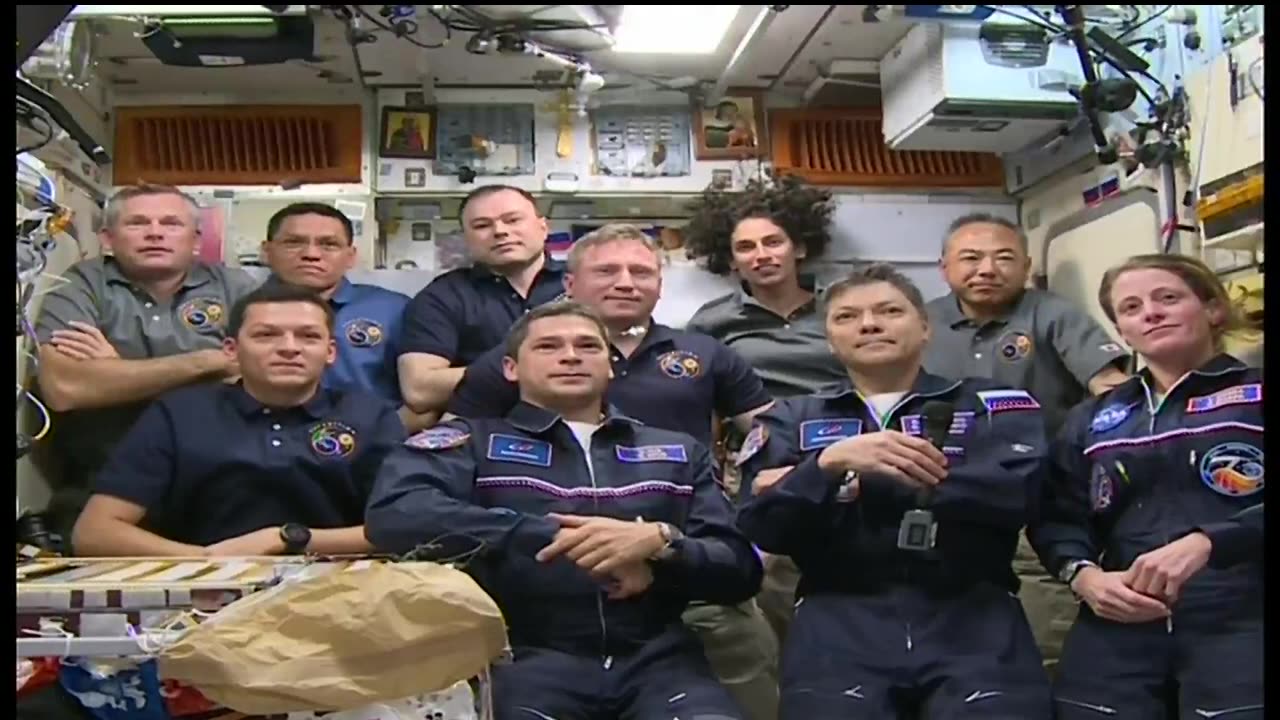Premium Only Content

Expedition 69/70 Soyuz MS-24 Launch Flight:
Certainly! Here are some of the highlights of Expedition 69/70 Soyuz MS-24 Launch Flight:
1. International Crew:
Expedition 69/70 was a testament to international cooperation in space exploration. The crew on board the Soyuz MS-24 spacecraft likely consisted of astronauts and cosmonauts from different countries, reflecting the collaborative nature of the International Space Station (ISS) program.
2. Scientific Research:
One of the primary purposes of missions to the ISS is to conduct scientific research in the unique microgravity environment of space. Expedition 69/70 would have featured a wide range of experiments across various disciplines, including biology, physics, and Earth sciences. These experiments contribute to our understanding of both space and Earth.
3. Routine Maintenance:
The ISS requires regular maintenance to ensure its continued functionality and the safety of its crew. During Expedition 69/70, the astronauts and cosmonauts would have performed maintenance tasks such as equipment repairs, software updates, and system inspections.
4. Technology Demonstrations:
Space agencies often use ISS missions as an opportunity to test new technologies and equipment for future space exploration endeavors. These demonstrations help refine and improve technology for missions beyond Earth orbit.
5. Health and Well-being:
Maintaining the physical and mental health of astronauts in the challenging environment of space is a top priority. The crew of Expedition 69/70 would have participated in health studies and exercises to ensure they remained fit and well during their stay on the ISS.
6. Earth Observation:
The ISS provides a unique vantage point for observing Earth. Crew members would have had the chance to take photographs and capture data on various natural phenomena, climate changes, and other Earth-related events, contributing to our knowledge of our planet.
7. Educational Outreach:
Expedition 69/70 would likely have included educational outreach efforts to engage students and the general public in space science and exploration. Astronauts on the ISS often communicate with schools and organizations on Earth to inspire and educate the next generation of space enthusiasts.
8. Crew Rotation:
The arrival of the Expedition 69/70 crew members at the ISS marked the departure of the previous crew, illustrating the continuous cycle of crew rotations on the space station. This rotation ensures a fresh perspective and ongoing presence on the ISS.
9. Safe Return:
At the end of their mission, the Expedition 69/70 crew would have returned to Earth aboard the Soyuz MS-24 spacecraft. A successful return demonstrates the reliability and safety of the Soyuz spacecraft for transporting astronauts to and from the ISS.
These highlights represent the multifaceted nature of Expedition 69/70 Soyuz MS-24 Launch Flight, showcasing the importance of the ISS for scientific research, international cooperation, and space exploration. Specific details about the mission's accomplishments and experiences would be available in post-mission reports and announcements.
Expedition mission to the International Space Station (ISS) like Expedition 69/70 Soyuz MS-24 Launch Flight might entail. For the most recent and accurate information, please consult official space agencies or reputable sources.
Expedition 69/70 Soyuz MS-24 Launch Flight:
Launch and Crew:
Expedition 69/70 Soyuz MS-24 is a mission to the International Space Station (ISS) conducted using the Soyuz MS-24 spacecraft. The launch date, specific crew members, and details may vary depending on the most current mission schedule, which can be obtained from space agencies like NASA or Roscosmos. Typically, the crew includes a commander and two flight engineers.
Spacecraft Overview:
The Soyuz MS-24 spacecraft is a modernized version of the long-standing Russian Soyuz program. It consists of three main modules: the Orbital Module, the Descent Module, and the Service Module. The Orbital Module contains living and working space, while the Descent Module is where the crew sits during launch and reentry. The Service Module houses systems and equipment necessary for the spacecraft's operation.
Mission Objectives:
The primary objectives of Expedition 69/70 Soyuz MS-24 Launch Flight include:
Transporting Crew to the ISS: The Soyuz MS-24 spacecraft carries astronauts to the ISS. Upon arrival, they join the existing crew and begin their mission aboard the station.
Scientific Research: Once aboard the ISS, crew members engage in a wide range of scientific experiments. These experiments contribute to various fields, such as physics, biology, materials science, and Earth sciences. The unique microgravity environment of the ISS allows for experiments not possible on Earth.
Routine Maintenance: The ISS requires regular maintenance to ensure its operational integrity and the safety of its occupants. Expedition 69/70 crew members participate in equipment repairs, system inspections, and software updates to maintain the station.
Technology Demonstrations: Space agencies often use ISS missions as a platform for testing new technologies and equipment for future space exploration endeavors. These demonstrations help refine and improve technology for upcoming #missions.
Health and Well-being: The physical and mental health of astronauts is crucial during extended space missions. The crew conducts health studies, exercises regularly, and monitors their well-being to ensure they remain fit and capable.
Earth Observation: The ISS provides a unique perspective for observing Earth. Crew members capture photographs and data on natural phenomena, climate changes, and other Earth-related events, contributing to our knowledge of the planet.
Educational Outreach: Expedition 69/70 may include educational outreach efforts where astronauts interact with schools and organizations on Earth to inspire and educate students and the public about space science and exploration.
Crew Rotation: With the arrival of the Expedition 69/70 crew, the previous crew members will depart the ISS. Crew rotations are routine and ensure a continual human presence on the space station.
Safe Return: At the conclusion of their mission, the Expedition 69/70 crew will return to Earth. The Soyuz spacecraft is equipped with heat shields and parachutes to facilitate a safe reentry and landing, typically in Kazakhstan.
Expedition 69/70 Soyuz MS-24 Launch Flight showcases the significance of the ISS for scientific research, international collaboration, and the advancement of space exploration. Detailed information about this specific mission, including its crew, experiments, and outcomes, can be obtained from the relevant space agencies and official mission reports.
-
 1:15:25
1:15:25
Graham Allen
3 hours agoTrump BULLIES Colombia Into Following His Policy!! + FINALLY PETE IS CONFIRMED!
32.4K72 -
 1:01:50
1:01:50
Kyle Fortch
2 hours agoCallum Kerr Joins Netflix’s Biggest Shows & Signs First Record Deal | THE ONE SHEET S1E1
2.63K1 -
 DVR
DVR
Matt Kohrs
9 hours agoMARKETS CRASH: The DeepSeek Panic || The MK Show
33.5K5 -
 39:56
39:56
BonginoReport
3 hours agoTrump Alpha-Males Colombia (Ep.126) - 01/27/2025
77.1K114 -
 1:59:53
1:59:53
Jeff Ahern
3 hours ago $1.31 earnedMonday Madness with Jeff Ahern (6am Pacific)
10K -
 1:21:30
1:21:30
Game On!
11 hours ago $1.94 earnedPatrick Mahomes does it AGAIN!
14.9K9 -
 15:20
15:20
Misha Petrov
3 hours agoReacting To Liberal MELTDOWNS Over Trump’s Return - Gen Z Is Planning a REVOLUTION?!
23.8K21 -
 18:22
18:22
Neil McCoy-Ward
4 hours agoThe 🇨🇴 Colombian President Just Learned The HARD WAY!!! (Another Win For The USA 🇺🇸)
38.3K14 -
 1:56:04
1:56:04
TheDozenPodcast
19 hours agoMass deportations, Islamists, Saving the UK: Nick Tenconi
41.4K23 -
 35:24
35:24
Survive History
23 hours ago $11.37 earnedCould You Survive in a Cavalry Regiment During the English Civil War?
105K10